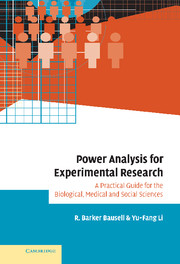 Power Analysis for Experimental Research
Power Analysis for Experimental Research Book contents
- Frontmatter
- Contents
- Introduction
- 1 The conceptual underpinnings of statistical power
- 2 Strategies for increasing statistical power
- 3 General guidelines for conducting a power analysis
- 4 The t-test for independent samples
- 5 The paired t-test
- 6 One-way between subjects analysis of variance
- 7 One-way between subjects analysis of covariance
- 8 One-way repeated measures analysis of variance
- 9 Interaction effects for factorial analysis of variance
- 10 Power analysis for more complex designs
- 11 Other power analytic issues and resources for addressing them
- Technical appendix
- Bibliography
- Index
7 - One-way between subjects analysis of covariance
Published online by Cambridge University Press: 28 August 2009
- Frontmatter
- Contents
- Introduction
- 1 The conceptual underpinnings of statistical power
- 2 Strategies for increasing statistical power
- 3 General guidelines for conducting a power analysis
- 4 The t-test for independent samples
- 5 The paired t-test
- 6 One-way between subjects analysis of variance
- 7 One-way between subjects analysis of covariance
- 8 One-way repeated measures analysis of variance
- 9 Interaction effects for factorial analysis of variance
- 10 Power analysis for more complex designs
- 11 Other power analytic issues and resources for addressing them
- Technical appendix
- Bibliography
- Index
Summary
Purpose of the statistic
The one-way analysis of covariance (ANCOVA) is used to ascertain how likely the difference(s) in means among two or more groups would be to occur by chance alone after the effects of one or more pre-existing variables have been taken into account (i.e., statistically controlled). As such, it is an extension of both the independent samples t-test (since it can be employed with only two groups) and the between subjects ANOVA model. This statistical control of a pre-existing variable (called a covariate) can be visualized as accomplishing three distinct functions:
In the presence of a pretest or baseline measure identical to the outcome variable, the results of a one-way ANCOVA can be interpreted as the extent to which the groups involved have changed over time. In this sense it is interpreted identically to the time (e.g., baseline vs. end-of-treatment) × treatment interaction in a mixed within group (repeated measures) design except that it does not provide for a main effect test of the hypothesis regarding an overall baseline to end-of-treatment change (see Chapter 9). As was discussed in Chapter 2, however, it is usually a slightly more powerful test of treatment changes than this two-factor model. If more than one post-baseline interval is used, as is often the case, then a factorial ANCOVA must be employed, although the effect of interest may now be the between group main effect (which combines means across these post-intervention assessments) rather than the interaction (see Chapter 10).
[…]
- Type
- Chapter
- Information
- Power Analysis for Experimental ResearchA Practical Guide for the Biological, Medical and Social Sciences, pp. 111 - 178Publisher: Cambridge University PressPrint publication year: 2002


